Tomahawk Missiles
- 25 Jun 2025
In News:
In a major escalation of the Iran-Israel conflict, the United States has reportedly launched precision strikes on Iran’s nuclear infrastructure, targeting key sites at Fordow, Natanz, and Esfahan. These attacks were carried out using Tomahawk cruise missiles and GBU-57 bunker busters, marking a critical intervention by the US in the unfolding regional crisis. President Donald Trump termed the strikes a “clear warning” to Iran, signalling the potential for intensified military action if diplomatic overtures are rejected.
What Are Tomahawk Missiles?
The Tomahawk missile is a long-range, subsonic, all-weather cruise missile primarily operated by the United States Navy and Royal Navy. It is designed for precision strikes on high-value or heavily defended targets, including hardened or buried infrastructure such as nuclear sites.
- Launch platforms: Ships and submarines
- Flight path: Low-altitude terrain-following flight to evade radar
- Use case: Strategic, surgical strikes in contested or defended environments
Design and Capabilities
- Length: ~5.6 meters (without booster)
- Weight: Up to 1,600 kg
- Speed: ~880 km/h (subsonic)
- Range: Over 1,600 km (varies by variant)
- Flight altitude: As low as 30–50 meters
- Warheads:
- Unitary high-explosive
- Cluster munitions
- Nuclear warheads (retired from use)
Navigation and Guidance Systems
Tomahawk missiles are known for pinpoint accuracy, achieved through a multi-layered guidance system:
- GPS (Global Positioning System) and INS (Inertial Navigation System) for real-time course tracking
- TERCOM (Terrain Contour Matching): Compares terrain under flight path with stored maps
- DSMAC (Digital Scene Matching Area Correlation): Matches live terrain imagery with onboard target data
- Data-link capability: Allows for in-flight re-targeting, mission abort, or loitering over areas
Variants and Modern Upgrades
- Tomahawk Block IV (TLAM-E): Most modern variant, featuring:
- In-flight reprogramming
- Target loitering
- Real-time battle damage assessment
- Two-way satellite communication
Historical Combat Usage
Tomahawk missiles have been extensively used in US military operations:
- Gulf War (1991): ~280 missiles used in the opening strikes
- Operation Infinite Reach (1998): Targeted terrorist camps in Sudan and Afghanistan
- Iraq War (2003): Hundreds used during the initial “shock and awe” campaign
- Libya Intervention (2011): Destroyed air defence infrastructure
- Syria (2017): 59 Tomahawks used against Shayrat Airbase in retaliation for chemical attacks
INS Tamal

- 25 Jun 2025
In News:
In a landmark development for India's maritime defence, the Indian Navy is set to commission its latest stealth multi-role frigate, INS Tamal, on 1st July 2025 at Yantar Shipyard, Kaliningrad, Russia
Overview:
- Class & Series: INS Tamal is the second ship of the Tushil-class, an upgraded variant of the Talwar and Teg class frigates, forming part of the Krivak class series built under Indo-Russian cooperation.
- Total Induction: With Tamal’s addition, India will operate ten ships with common capabilities across four related classes.
- Construction: Built at Yantar Shipyard with oversight from Indian specialists under the Warship Overseeing Team (WOT), Kaliningrad, under the Embassy of India, Moscow.
Symbolism and Identity
- The name ‘Tamal’ represents the mythical sword of Indra, the King of Gods.
- The ship’s mascot blends India’s Jambavant, the immortal bear king of mythology, with Russia’s Eurasian Brown Bear, symbolising Indo-Russian defence cooperation.
- The ship’s motto: ‘Sarvada Sarvatra Vijaya’ (Victorious Always Everywhere).
Make in India & Indigenous Content
- INS Tamal is the last warship to be inducted from a foreign source, aligning with Aatmanirbhar Bharat and Make in India initiatives.
- 26% indigenous content, including:
- BrahMos supersonic cruise missiles (anti-ship & land attack roles)
- HUMSA NG Mk II sonar, Indian radars, and communication systems
- Indian OEMs involved: BrahMos Aerospace, BEL, Keltron, Nova Integrated Systems (Tata), Elcome Marine, Johnson Controls India, among others.
- Indigenous components have more than doubled to 33 systems compared to previous imports.
Key Features & Capabilities
- Displacement: 3,900 tonnes | Length: 125 metres
- Top speed: Over 30 knots
- Armament & Combat Systems:
- Vertically Launched Surface-to-Air Missiles (VL-SAM)
- Improved 100 mm main gun, 30 mm CIWS
- Heavyweight torpedoes, anti-submarine rockets
- EO/IR system, fire control radars
- Aviation Support: Flight deck for Air Early Warning & Multi-Role helicopters
- Sensors & Network:
- Surface Surveillance Radar
- Advanced Electronic Warfare suite
- Network Centric Warfare capabilities
- Trials: Successfully completed 3-month sea trials, validating systems and weapons in challenging winter conditions (St. Petersburg & Kaliningrad).
Strategic Importance
- Upon commissioning, INS Tamal will join the Indian Navy’s Western Fleet—the 'Sword Arm' of the Navy under Western Naval Command.
- Reinforces India’s blue water naval ambitions, enhancing operational readiness in multi-threat maritime environments.
- Embodies two decades of Indo-Russian naval cooperation and represents a transition towards domestic warship production.
Gwada Negative

- 25 Jun 2025
In News:
In a landmark discovery for transfusion science, France’s national blood agency (Établissement Français du Sang – EFS), in June 2025, identified a completely new blood group system. Officially recognized by the International Society of Blood Transfusion (ISBT) as the 48th blood group system, it is termed EMM-negative and is informally called “Gwada Negative”, after Guadeloupe, the origin of the only known individual with this blood type.
What is Gwada Negative (EMM-negative)?
- EMM-negative is defined by the absence of the EMM antigen, a high-incidence antigen normally present on red blood cells in nearly all humans.
- High-incidence antigens are so common that individuals lacking them are considered extremely rare and face critical challenges in blood transfusion compatibility.
- The ISBT registered this as ISBT042, making it the latest addition to global blood group systems.
Discovery Timeline
- 2011: A 54-year-old woman from Guadeloupe, living in Paris, underwent pre-surgical blood testing. Her blood showed unidentified antibodies that did not match any known blood group systems.
- 2019: With advancements in Next-Generation Sequencing (NGS), researchers led by Dr. Thierry Peyrard (EFS) identified the unique genetic mutation responsible for the absence of the EMM antigen.
- 2025: After peer-reviewed validation, the ISBT officially recognised the EMM-negative system during its Milan meeting.
Why is it So Rare?
- This woman is the only known person in the world with the EMM-negative blood type.
- She inherited the rare gene mutation from both parents, leading to a complete absence of the EMM antigen in her red blood cells.
- Since the EMM antigen is nearly universal, her blood is compatible only with itself, making transfusions extremely high-risk unless a genetically identical donor is found.
Clinical Significance
- Individuals lacking high-incidence antigens like EMM may develop alloantibodies — immune responses against transfused red cells containing those antigens.
- Transfusion of EMM-positive blood into such individuals can cause hemolytic reactions, including life-threatening hemolysis (premature red blood cell breakdown).
- In this case, no donor blood currently available is safe for transfusion into the patient.
Implications for Transfusion Medicine
- Highlights the need for rare blood donor registries, international cooperation, and advanced genetic screening technologies to identify such rare phenotypes.
- Encourages development of precision-matching protocols in complex clinical and emergency situations.
- Expands the understanding of human immunohematological diversity and redefines transfusion compatibility standards.
Kounis Syndrome
- 25 Jun 2025
In News:
The recent sudden death of Indian industrialist Sanjay Kapur during a polo match in London has drawn national attention to Kounis Syndrome, a rare but serious medical condition. Reports suggest he may have inhaled a bee, which stung him inside the throat—leading to a cardiac arrest, potentially triggered by an acute allergic reaction. This tragic incident has raised awareness about the interaction between allergic reactions and cardiac emergencies, especially in seemingly healthy individuals.
What is Kounis Syndrome?
Kounis Syndrome is a rare medical condition in which a severe allergic or hypersensitivity reaction triggers a coronary event, such as a heart attack. It is often termed “allergic angina” or “allergic myocardial infarction.”
Mechanism
- Triggered by allergens such as insect stings, drugs, or foods.
- Leads to the activation of mast cells, which release histamine and cytokines.
- These chemicals cause spasms, plaque rupture, or clot formation in coronary arteries.
- Result: Reduced blood flow to the heart, causing ischemia or infarction.
Types of Kounis Syndrome
- Type I: In individuals with normal coronary arteries – allergic reaction causes artery spasm and possible heart attack.
- Type II: In those with existing coronary artery disease – allergic reaction destabilizes plaques, causing infarction.
- Type III: In patients with coronary stents – hypersensitivity leads to thrombosis within stents.
Triggers of Kounis Syndrome
- Insect stings (bee, wasp)
- Medications (NSAIDs, antibiotics)
- Foods (nuts, shellfish, kiwi)
- Environmental allergens (latex, contrast dyes)
- Underlying health conditions (e.g., mastocytosis)
Symptoms
- Chest pain
- Shortness of breath or wheezing
- Swelling (angioedema), hives, or rash
- Low blood pressure
- ECG changes: ST-segment elevation or depression
Diagnosis and Treatment
- Diagnosis: Clinical history, ECG, cardiac enzymes, allergy tests.
- Treatment includes:
- For allergy: Antihistamines, corticosteroids, epinephrine
- For cardiac care: Oxygen, nitrates, antiplatelet drugs, beta-blockers
Why Mouth/Throat Bee Stings Are Dangerous
- Immediate airway swelling
- Increased absorption of venom into bloodstream
- Enhanced risk of anaphylaxis and cardiac arrest
Even people without a history of allergy can experience severe reactions if stung inside the mouth or throat.
Warning Signs After a Bee Sting
- Difficulty breathing
- Swollen lips, tongue, or throat
- Rash or itching
- Dizziness or fainting
- Rapid or weak heartbeat
- Nausea or unconsciousness
Immediate emergency care is essential.
Himalayan Brown Bear
- 25 Jun 2025
In News:
In a significant development for Himalayan biodiversity, a rare sighting of a Himalayan Brown Bear with its family has been reported for the first time in the Dumka region between Nelang and Bhairon Ghati, within Gangotri National Park, Uttarakhand. The sighting has enthused wildlife experts and is viewed as a positive indicator of range expansion and ecosystem resilience in this fragile high-altitude region.
Significance of the Sighting
- This marks the first recorded presence of a brown bear in this specific stretch of the park.
- Previously, sightings were limited to Gomukh (6 bears) and Kedartal (3 bears), both located above 3,000 m.
About the Himalayan Brown Bear
- Scientific Name: Ursus arctos isabellinus
- Common Names: Himalayan Red Bear, Isabelline Bear; known as Denmo in Ladakhi.
- It is believed to be one of the most ancient brown bear lineages and may have inspired the Yeti legend due to its upright gait.
Distribution and Habitat
- Found in the northwestern and central Himalayas: India, Pakistan, Nepal, Bhutan, and China (Tibet).
- In India: Exists in fragmented populations in Jammu & Kashmir, Himachal Pradesh, and Uttarakhand.
- Inhabits elevations between 3,000 and 5,500 meters, usually above the timberline in alpine meadows and snow-clad regions.
Ecological Features
- Size: Males average 1.9 m and 135 kg; females 1.6 m and 70 kg.
- Fur: Sandy or reddish-brown; thick to endure high-altitude cold.
- Diet: Omnivorous – consumes roots, berries, nuts, small mammals, fish, and insects.
- Behavior: Solitary, except during mating or a mother with cubs; hibernates during winter in dens.
- Lifespan: 20–30 years in the wild.
Conservation Status
- IUCN Red List: Critically Endangered
- Wildlife (Protection) Act, 1972 (India): Schedule I
- CITES: Appendix I
